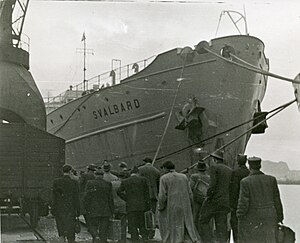 Displaced Persons about to board HNoMS Svalbard (ex-Togo) in Genoa, Italy, in December 1948 for resettlement in Australia
| |
| History | |
|---|---|
| Name | Togo |
| Namesake | Togo |
| Operator | Woermann-Linie |
| Builder | Bremer Vulkan, Vegesack |
| Launched | 13 August 1938 |
| Homeport | Hamburg |
| Identification |
|
| Fate | Requisitioned by Kriegsmarine, 1939 |
| Name | Schiff 14 |
| Namesake | Battle of Coronel |
| Operator | Kriegsmarine |
| Builder | Wilton, Rotterdam |
| Yard number | 10 |
| Acquired | Requisitioned, 1939 |
| Recommissioned | December 1942 |
| Renamed | (HSK Coronel, 1942) |
| Reclassified |
|
| Homeport | Kiel |
| Nickname(s) |
|
| Fate | Transferred to the Luftwaffe, 1943 |
| Name | Togo |
| Operator | Luftwaffe |
| Acquired | 1943 |
| Recommissioned | 1943 |
| Reclassified | Night fighter guide ship, 1943 |
| Homeport | Kiel |
| Fate | War booty, 1945; transferred from UK to USA, then to Norway |
| Badge |  |
| Name | Svalbard, then Tilthorn and Stella Marina |
| Acquired | 14 March 1946 |
| Fate | Sold |
| Name | Togo |
| Operator | Deutsch Afrikanische Schiffahrts GmbH, Hamburg |
| Acquired | November 1956 |
| Fate | Sold |
| Name | Lacasielle, then Topeka |
| Acquired | March 1968 |
| Identification | IMO number: 5363029 |
| Fate |
|
| General characteristics As NJL Togo | |
| Type | Night fighter guide ship |
| Displacement | 12,700 t (12,500 long tons)[1] |
| Length | 134 m (439 ft 8 in) |
| Beam | 17.9 m (58 ft 9 in) |
| Draft | 7.9 m (25 ft 11 in) |
| Installed power | 5,100 hp (3,800 kW) |
| Propulsion |
|
| Speed | 16 kn (30 km/h; 18 mph) |
| Endurance | 36,000 nmi (67,000 km; 41,000 mi) at 10 kn (19 km/h; 12 mph)[2] |
| Complement | 283 crew plus 74 radar specialists from the Luftwaffe |
| Sensors and processing systems |
|
| Armament |
|
| Aircraft carried | She could guide two night fighters simultaneously |
MS Togo was a German merchant ship that was launched in 1938. Requisitioned by Nazi Germany's Kriegsmarine as Schiff 14, in April 1940 she participated in the invasion of Norway; in August 1940 was converted to a minelayer as part of the German plan to invade England; then from June 1941 she began conversion to the armed auxiliary cruiser (Hilfskreuzer) HSK Coronel.
Following Coronel's unsuccessful attempt in February 1943 to become the last German commerce raider of World War II, she was then used as a minesweeper (Sperrbrecher) before being recommissioned in late 1943 as NJL Togo, a night fighter direction vessel (Nachtjagdleitschiff), operating in the Baltic Sea.
As NJL Togo, she was the second of the Kriegsmarine's World War II radar ships, and the only one to survive the war.[3]
After the war, Togo passed through various changes of ownership, name and function before finally being wrecked off the Mexican coast in 1984.
- ^ Not to be confused with the figure of 5042 BRT (Brutto Register Tonnage, equivalent to Gross Register Tonnage, used as a measure of the cargo carrying capacity of ships, not their displacement) which is quoted for Togo by some sources. Retrieved 27 May 2010
- ^ John Asmussen, Hilfskreuzer (Auxiliary Cruiser) Coronel Retrieved 28 May 2010
- ^ The first had been the NJL Kreta (ex-French Ile de Beauté) which had been taken over by the Kriegsmarine in January 1943 and was rebuilt for use as a fighter direction ship. The conversion was completed in August 1943. The ship was lost on September 21, 1943, near the island of Capraia in the Tyrrhenian Sea, after being torpedoed by the British U-class submarine HMS Unseen. In September 1943, Premuda was equipped with Freya-type radar for a time in order to operate as a radar picket and fighter direction ship, but she never served in this capacity; she was recoverted into a destroyer, renamed TA32 and, based in Genoa, served in the Ligurian Sea until being scuttled on 25 April 1945.